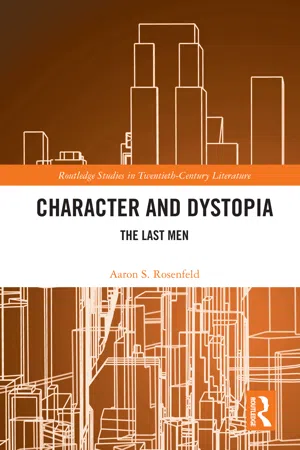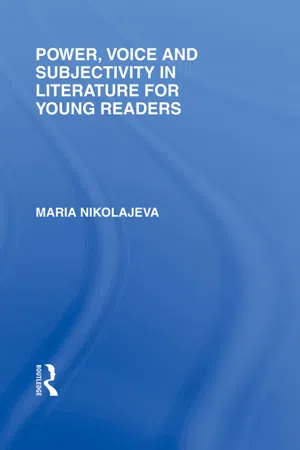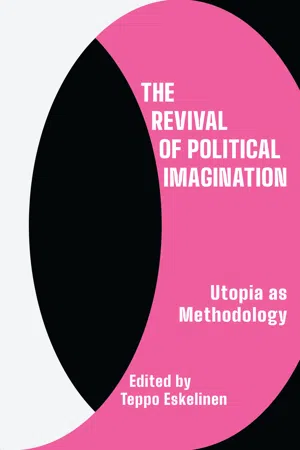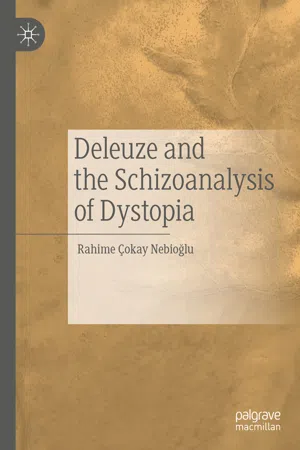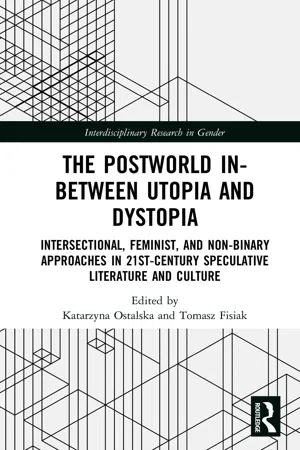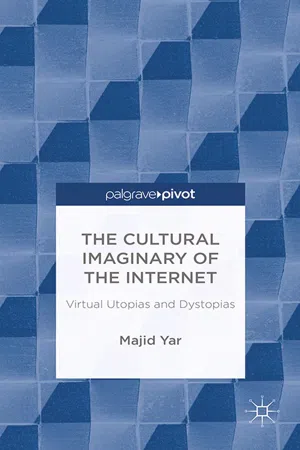Dystopian Fiction
Dystopian fiction is a genre that presents a society characterized by oppression, suffering, and often a totalitarian government. These narratives typically explore themes of control, surveillance, and the consequences of unchecked power. Dystopian fiction often serves as a cautionary tale, prompting readers to reflect on the potential consequences of societal and political choices.
8 Key excerpts on "Dystopian Fiction"
...Dystopia “is largely the product of the terrors of the twentieth century. A hundred years of exploitation, repression, state violence, war, genocide, disease, famine, ecocide, depression, debt, and the steady depletion of humanity through the buying and selling of everyday life provided more than enough fertile ground for this fictive underside of the utopian imagination” (Moylan 2000: ix). Dystopia demands we examine our moral categories and judgments. Dystopian authors call our attention to the use and abuse of language for repressive proposes. They ask us to reconsider our assumptions about human nature and the limits of politics. Utopian thought needs dystopia. Dystopian thought warns against the dangers of utopian ideologies. Dystopia can be an “attempt to show, by as graphic and detailed a portrayal as possible, the horror of a society in which utopian aspirations have been fulfilled” (Kumar 1987: 109). Dystopias are projections of existing negative trends. Lyman Tower Sargent defined dystopia as “a non-existent society described in considerable detail and normally located in time and space that the author intended a contemporaneous reader to view as considerably worse that the society in which that reader lived” (1994: 9). Russell Jacoby said “dystopias seek to frighten by accentuating contemporary trends that threaten freedom” (2005: 13). Margaret Atwood describes dystopias as projections of current events carried to their logical extremes. In this way, “every dystopia is a history of the future” (Lepore 2017). Hope provides the essential focus of utopian thought. Fear provides the essential focus in dystopia. As Gregory Claeys says, “the central theme of the modern dystopia is despotism,” producing “the estrangement and isolation of individuals, and their fear of each other” (2017: 290). The true horror of dystopia lies in the loss of trust among human beings. In a dystopian state people cannot join together to challenge the conditions of their existence...
- eBook - ePub
Character and Dystopia
The Last Men
- Aaron S. Rosenfeld(Author)
- 2020(Publication Date)
- Routledge(Publisher)
...As a result, dystopian worlds have less contingency than the fictional modes usually linked to realism. Character remains free, but setting disallows the practice of that freedom. Dystopias deny the freedom of the novel’s alternate possibilities.Dystopian NarrativeIf as a self-contained literary form the dystopia is relatively new, the pre-history of dystopia suggests that the impulse to imaginatively realize a perfectly awful world is perennial. Claeys notes that dystopic imaginingsof the “triumph of chaos over order” can be found as early as 1000 BC in the apocalyptic writings of the “Egyptian Prophecies of Nefertiti;” the condition of slavery provides another touchstone, while Christianity provides its own visions of apocalyptic collapse.44What modern dystopian novels add to these formulae are colorings of urgent or imminent contemporary threats, but also new characters, anchoring them in thoroughly modern, if constantly evolving, perspectives.If utopia necessarily privileges the collective over the individual, dystopia privileges the individual over the collective...
- Maria Nikolajeva(Author)
- 2009(Publication Date)
- Routledge(Publisher)
...In fact, such an interrogation is one of the many stereotypes of the dystopian novel for young readers. Further, in accordance with the conventions of children’s literature, a child or a young person questions the society and reaches the insight about its injustice, but it is the adult society that suppresses the revolt. In this chapter I have chosen to illustrate recurrent dystopian features by a number of recent novels such as The Giver (1993), by Lois Lowry, The Denials of Kow-Ten (1998), by Jenny Robson, Noughts and Crosses (2001), by Malorie Blackman, Whither You Long (2001), by Ylva Karlsson, and Feed (2002), by M. T. Anderson. Since these books come from different parts of the world, I find it symptomatic that they have so much in common. Many critics treat utopias and dystopias as two closely connected literary categories. Fredric Jameson (2005) makes no distinction between utopia and dystopia; moreover, with his political spectacles, utopia is dystopian by definition. He views utopia as a political idea, rather than a literary genre; the closest he gets to genre criteria is satire. Most of his material is science fiction in its political interpretation. A recent volume of children’s literature criticism (Hintz and Ostry 2003), also treats utopia very broadly. Yet I find it necessary to distinguish between utopia and dystopia. If utopian literature depicts an ideal, albeit inaccessible, society, a dystopia is a picture of fear, a picture of a society which we would prefer to avoid, a warning. Both genres can be employed to investigate the issues of power and oppression, but in radically different ways. Contemporary dystopias for young readers display a number of stereotypes that are gratifying to investigate from the power point of view. Stereotypes as such are strong power factors since they confirm the existing order...
- eBook - ePub
The Revival of Political Imagination
Utopia as Methodology
- Teppo Eskelinen, Teppo Eskelinen(Authors)
- 2020(Publication Date)
- Zed Books(Publisher)
...5 | SOCIAL DREAMING AND USES OF NARRATIVITY, TELLABILITY AND EXPERIENTIALITY IN LITERARY DYSTOPIA Maria Laakso Immediately after Donald Trump’s inauguration as the president of the United States in January 2017, something quite unusual happened in the American book market. Sales of dystopian classics like Aldous Huxley’s Brave New World (1932) or Ray Bradbury’s Fahrenheit 451 (1953) skyrocketed. Within a week, George Orwell’s Nineteen Eighty-Four (1949) spiked from Amazon’s 89 th most sold book to the No. 1 best-selling book. It seems that the authoritarian overtones in Trump’s political campaigning increased the sales of dystopian classics instantly, once the election results revealed that this would also be the tone of forthcoming presidential politics. The sudden rise of old dystopian classics as a reaction to the contemporary political changes suggests that literary dystopia has an ability to work as a tool for reflecting the contemporary society and imagining possible futures. By definition, literary dystopias display terrible and unpleasant worlds, conditions and societies. Furthermore, dystopian literature is typically also seen to criticize trends and flaws in contemporary society (Baccolini and Moylan 2003, 2 – 5 ; Mohr 2005, 28). Dystopia therefore not only imagines possible future conditions, but also mirrors existing reality. This kind of duality is one of its most identifiable genre features, being also characteristic of literary utopias. Dystopias are often treated as warnings about what will happen if a given practice or trend continues, or as thought experiments on the outcomes of practices or trends. However, it is important to note that Dystopian Fiction seems to serve its mirroring function, also for readers who can no longer relate to the temporal moment when a dystopia has been written, as is seen in the sudden rise in popularity of classic dystopias...
- Carrie Hintz, Elaine Ostry, Carrie Hintz, Elaine Ostry(Authors)
- 2013(Publication Date)
- Routledge(Publisher)
...From the Wreckage: Post–World War II Dystopias and Utopias Presenting the Case for Social Change: The Creative Dilemma of Dystopian Writing for Children Kay Sambell DOI: 10.4324/9780203953884-18 Since the late 1960s the futuristic fiction written for young readers has been disposed to make serious and disturbing comment on the likely direction of human civilization. During the 1970s and to the present day, a dark literature of emergency and despair has developed, expressing deep-rooted fears for the future of those children being addressed. As this dystopian genre has developed, its nightmarish imaginative landscapes have become increasingly intolerable, presenting a variety of repressive and tyrannically controlled states, whether writers conceive these as being neoprimitive or hypertechno-logical in essence. In the 1980s devastatingly bleak visions of the horrifying aftermath of nuclear war emerged, adding new levels of pessimism and concern about the future. Writers’ hypotheses about humankind’s likely lines of development have proved far from optimistic, and this large genre in children’s publishing has become characterized by extreme, arguably unprecedented, levels of anxiety and hopelessness. Commentators frequently refer to this dystopian futuristic literature’s “purpose” or “function,” which is usually perceived to be twofold. First, the literature primarily cautions young readers about the probable dire consequences of current human behaviors. Second, as Eric Rabkin notes, it is driven by the impulse to counsel hope and present the case for urgent social change. 1 Like all admonitory literature, it acts as what Barbara Harrison describes as a “call of the imagination to the ethical,” 2 and represents an authorial quest to suggest a new moral course for young readers. It seeks to shock its readership into a realization of the urgent need for a radical revisioning of current human political and social organization, and even of human nature itself...
- eBook - ePub
- Rahime Çokay Nebioğlu(Author)
- 2020(Publication Date)
- Palgrave Macmillan(Publisher)
...Following the passage from the totalitarian nation-states to seemingly libertarian global societies, contemporary dystopia has begun to display some significant divergences from earlier examples in terms of the motivations in its representation, temporality and plot mechanisms. Unlike the earlier examples of dystopia which depict imaginary representations of a possible future that is remarkably worse than the present society, contemporary dystopia often tends to portray an imaginary and almost allegorical re-presentation of the present society which could not get worse than its current state. Abandoning the tendency in earlier examples to condemn the resistant dissenter to an inevitable failure in his or her resistance to society, contemporary dystopia now appears relatively more hopeful and inclined to offer multiple affirmative ways of resistance and alternative modes of life in and for the present society. Thus, dystopia in the new millennium has passed from a progress-driven form to a process-oriented form that places the emphasis on the actual societies rather than on possible ones. This book suggests that this passage could simultaneously envision a new phase in the history of dystopia as a literary form, and attempts to explore this new phase alongside Deleuzian philosophy. As we shall see, this attempt will involve offering as full and clear a Deleuzian interpretation of the history of dystopia and the contemporary world as possible, identifying and outlining a significant shift in the politics of dystopia and conceptualising a new definition of it that would correspond to this shift. In recent years, a growing number of studies have begun to define and describe the shift that has been going on in contemporary dystopia...
- eBook - ePub
The Postworld In-Between Utopia and Dystopia
Intersectional, Feminist, and Non-Binary Approaches in 21st-Century Speculative Literature and Culture
- Katarzyna Ostalska, Tomasz Fisiak, Katarzyna Ostalska, Tomasz Fisiak(Authors)
- 2021(Publication Date)
- Routledge(Publisher)
...It is quite symptomatic that a monograph published in 2020, Watkins’s Contemporary Women’s Post-Apocalyptic Fiction, edits out the feminist perspective and comments dismissively: “‘Feminist values’—and how exactly do we define these?—can be used to facilitate dystopian as well as utopian ends” (22). In contrast, this collection does not put feminist values in inverted commas. What can be perceived as their alleged non-definability may be the biggest strength of 21st-century feminisms: as is argued here, the utopian need for different, more hopeful futures cannot be complete without the feminist social and political programme. From speculative fiction, science fiction, dystopian and utopian texts to utopian becoming Jameson considers “Utopia to be a socio-economic sub-genre” of literary science fiction (Archeologies, xiv). As a genre, science fiction can be characterised by two main elements: it is strongly intertwined with technology and is future-oriented (Melzer 4). Melzer argues: Science fiction’s fantastic aliens and distant planets can thus become the imaginative testing grounds for feminist critical thought. These texts create a link between the cultural imagination and political positions: they function as “case studies” of how feminist theories “work.” (10) Commonly, the term “science fiction” is used interchangeably with the much broader speculative fiction. Atwood, however, confines the term “speculative fiction” to narratives that are possible when taking into account the current state of knowledge, scientific advancement, even if not actually realised, and science fiction to the realm of purely imaginative narratives, such as time travels or life on other planets (Moving 92–93). Seemingly familiar terms, utopia and dystopia, are more complicated than one would assume. To begin with, Moylan reminds us that the opposition of utopia is not dystopia but its extreme form, anti-utopianism. Anti-utopia is dystopia’s worst possible arrangement (Scraps 189)...
- eBook - ePub
The Cultural Imaginary of the Internet
Virtual Utopias and Dystopias
- M. Yar(Author)
- 2014(Publication Date)
- Palgrave Pivot(Publisher)
...Raymond Williams (1978: 203) notes that the literary genre of science fiction is founded in significant part upon the narrative device of a ‘ technological transformation in which a new kind of life has been made possible by a technical discovery’. This imaginative appropriation of techno-science also finds its inverted form in the proliferation of modern dystopias. Like the utopianism noted above, technology occupies a central place in revolutionising society, but does so from the perspective that ‘the conditions of life have been worsened by technical development’ (Ibid.: 204). Beginning with the Romantic reaction against Enlightenment rationalism, typified by Mary Shelley’s Frankenstein (1817), techno-scientific dystopias remain a recurrent and increasingly dominant feature of modern cultural production. In both their ‘positive’ and ‘negative’ incarnations, techno-scientific utopias create the fundamental template for contemporary utopias of the virtual realm....

